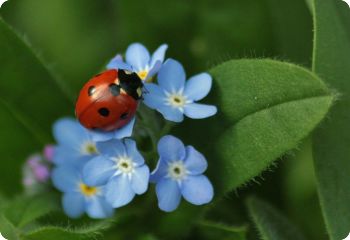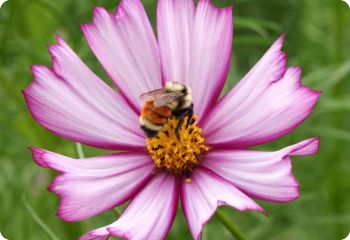Flowers for Beneficial Insects
by Diane Linsley
What are the best flowers for beneficial insects?
Most gardeners are aware of the importance of planting flowers for beneficial insects. Not only are beneficial insects good for your garden, but they are also useful to have around when teaching children about nature. Children are fascinated by beneficial insects - especially the all-time-favorite ladybug.
If you have small children, consider planting only edible flowers in the vegetable garden, so they don't get confused about what's safe to eat. Other flowers can be planted in a border outside the vegetable garden. Be cautious and well-informed before eating any plant or flower. Some people are allergic to certain flowers.
It's usually best to stick with annual flowers inside the vegetable garden, since you'll be rotating your crops every year. It's nice to have a special section for perennial flowers, maybe as part of the herb garden. Some herbs are perennials or biennials, so they need a permanent spot where they won't be disturbed by digging or rototilling.
Here are some of the best flowers for beneficial insects. You can also plant flowers that attract hummingbirds and butterflies. These garden visitors are good pollinators. And did you know that hummingbirds eat aphids?
Annual Flowers for Beneficial Insects
Alyssum - Masses of tiny white, pink or purple flowers that attract beneficial insects like parasitic mini-wasps and hoverflies.
Basil - A popular herb with flowers for beneficial insects and bees. The aromatic foliage may repel tomato hornworms and aphids.
Borage - Hardy annual herb that is highly recommended for bee forage. The edible flowers are nice to have for the kitchen.
Calendula - Orange, apricot or yellow flowers. The petals are edible. Attracts hoverflies and bees. Easy to grow from seed.
California Poppy - Native wildflower that blooms in a wide range of colors. Heat and drought tolerant. Attracts bees and hoverflies.
Centaurea cyanus (Cornflower) - Colorful flowers for beneficial insects, including bees, ladybugs, lacewings, hoverflies, and parasitic mini-wasps. Easy to grow from seed.
Cilantro (Coriander) - This lovely herb has white umbel flowers that attract hoverflies, parasitic wasps, ladybugs and lacewings.
Cosmos - Showy flowers that attract beneficial insects, including lacewings, hoverflies, parasitic mini-wasps, and predatory beetles. Easy to grow from seed.
Dill - This herb can be used as a trap crop for aphids. The umbel flowers attract hoverflies, ladybugs, lacewings, and parasitic mini-wasps.
German Chamomile - Annual herb with small, daisy-like flowers from summer to fall. Attracts bees, hoverflies, syrphid flies, tachinid flies, and parasitic wasps.
Marigold - Annual flowers for beneficial insects. French marigolds repel root nematodes. Easy to grow from seed.
Monarda citriodora (Lemon Beebalm) - Annual herb with fragrant leaves that can be used in teas. Native to the United States and Mexico. The pink, whorled flowers attract bees, butterflies and hummingbirds.
Morning Glory - Large, showy flowers that attract ladybugs and syrphid flies. Grow this vigorous vine on a trellis.
Nigella (Love-in-a-Mist) - Easy-to-grow, self-sowing annuals. The flowers attract bees. The seeds of some species are edible.
Snapdragon - One of the best flowers for bumblebees.
Sunflower - Large flower heads loaded with pollen that attracts beneficial insects and butterflies. A host plant for many butterfly species.
Tithonia rotundifolia - Large, bushy annual with orange-red, daisy-like flowers that attract hoverflies and minute pirate bugs. Native to Mexico.
Viola - I let violas self-sow wherever they like. They don't disturb the vegetables, and the edible flowers make nice cake decorations. Attracts a variety of small beneficial insects in the cool weather of early spring and autumn when there are few other flowers in the garden.
Zinnia - Brightly colored flowers that attract beneficial insects, including bees, hoverflies, ladybugs, and parasitic mini-wasps. Easy to grow from seed.
Perennial Flowers for Beneficial Insects
Agastache foeniculum (Anise Hyssop) - Native wildflower. Perennial herb with licorice-flavored leaves that are nice for teas. Spikes of lavender-blue flowers that attract bees, butterflies and hummingbirds. First-year flowering perennial.
Alyssum saxatile (Basket of Gold) - The bright yellow flowers bloom in late spring before most other flowers get started, providing an early food source for ladybugs and hoverflies.
Asclepias tuberosa (Butterfly Weed) - Native wildflower. Bright orange flowers that attract bumblebees, honeybees and hummingbirds. Host plant for several butterfly species.
Bronze Fennel - Yellow umbel flowers that attract ladybugs, lacewings, hoverflies, parasitic mini-wasps, and predatory beetles.
Common Chives (Allium schoenoprasum) - The flowers attract hoverflies, bees and parasitic mini-wasps. The leaves and flower buds are used in cooking.
Echinacea (Purple Coneflower) - Native wildflower. Used in herbal medicine as an immune stimulant. The flowers attract parasitic min-wasps, praying mantis, and bees. The ripening seed heads attract birds.
Feverfew (Tanacetum parthenium) - A traditional herb used to treat migraine headaches. The white, daisy-like flowers attract hoverflies. Self-sows.
Gaillardia - Native wildflower. Showy, scarlet-red and yellow flowers that attract native bees and butterflies. Easy to grow from seed.
Garlic Chives (Allium tuberosum) - The flowers attract beneficial insects and bees. The leaves have a nice, strong, garlic flavor. Allium species make good companion plants for roses because they repel aphids.
Hesperis matronalis (Dame's Rocket) - The young leaves are edible. The flowers attract bees and butterflies, which are important pollinators.
Hyssop (Hyssopus officinalis) - Perennial herb with dark, violet-blue flowers for butterflies, bees and bumblebees. The leaves are used in cough remedies.
Lemon Balm (Melissa officinalis) - A good tea herb with lemon-scented leaves. The flowers attract beneficial insects, including hoverflies, tachinid flies, and parasitic mini-wasps.
Linum narbonense 'Heavenly Blue' (Flax) - Delicate, sky-blue flowers that attract native bees, honeybees and butterflies.
Myosotis sylvatica (Forget-Me-Not) - Self-sowing biennial with tiny blue flowers that attract bees, butterflies and ladybugs in early spring.
Parsley - The umbel flowers attract many beneficial insects such as lacewings, tachinid flies, ladybugs, hoverflies, and parasitic wasps.
Penstemon strictus (Rocky Mountain Penstemon) - Native perennial. Tall spikes of vivid blue flowers that attract ladybugs, hoverflies, native bees, bumblebees and hummingbirds.
Rudbeckia (Black-Eyed Susan) - Native wildflower. Daisy-like flowers for beneficial insects, including lacewings and bees.
Ruta graeolens (Rue) - Attracts small parasitic wasps. Repels Japanese beetles and cucumber beetles. Host plant for Swallowtail butterflies.
Thyme - English thyme is a kitchen herb. Creeping thyme is a perennial groundcover. The tiny flowers attract hoverflies.
Related Articles
Flowers for Butterflies - Attracting butterflies with nectar and host plants.
Flowers for Hummingbirds - The best flowers for attracting hummingbirds.
Self-Sowing Annuals - Flowers that reseed and come back every year.
Recommended Books
Attracting Native Pollinators by The Xerces Society
Gardening for Butterflies: How You Can Attract and Protect Beautiful, Beneficial Insects by The Xerces Society
Seeds

